Hernia Laparoscopic
Dr. Nikhil Shellagi
MS Surgery, DNB Surgical Gastroenterology Fellowship in HPB and Liver Transplantation

Laparoscopic Hernia Surgery in Bangalore
Hernia Laparoscopic
This is nothing but the abnormal exit of tissue or organ (such as intestine, omentum, etc) from the wall of the cavity in which it normally resides. When the inside layers of the abdominal wall weaken, they bulge or tear, resulting in a hernia.
This, in turn, can cause a loop of intestine or abdominal tissue to slip into the sac, causing severe pain and other potentially dangerous health problems. As hernias are asymptomatic, they may produce no symptoms or they may produce slight to severe symptoms.
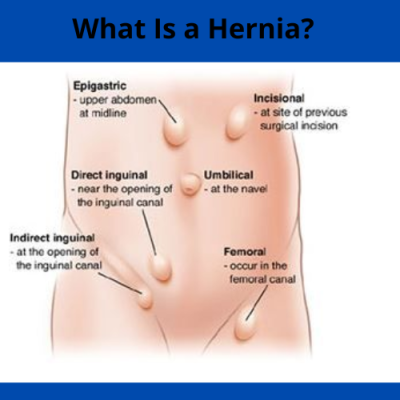
How is laparoscopic (minimally invasive) hernia repair performed?
1} A laparoscope, a thin, telescope-like device that is introduced through a small incision at the umbilicus, is used in laparoscopic hernia repair (belly button).
2} Before the surgery, you will undergo a general health assessment that includes a history, physical exam (and possibly lab work), and an electrocardiogram because this treatment is typically done under general anaesthesia (EKG).
3} During this procedure, you won’t experience any pain. An “inside view” of your body is shown onto television screens in the operating room thanks to a laparoscope that is attached to a tiny video camera no bigger than a dime.
4} The abdomen is inflated with a harmless gas (carbon dioxide) to make room for your doctor to check your internal structures. The peritoneum (the inner lining of the abdomen) is cut to expose the abdominal wall weakness. Mesh is placed inside the abdominal wall to cover as well as strengthen the tissue.
5} The small abdominal wounds are stitched or covered with surgical tape after the surgery is finished. The incisions become hardly invisible after a few months.
6} Laparoscopic hernia and liver surgery have advantages such as three small scars as opposed to one large incision, reduced post-surgery pain, quicker return to work, and quicker recovery (days instead of weeks).
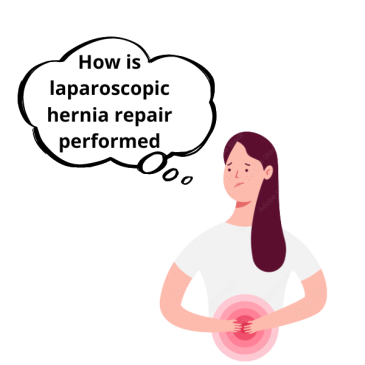
What are the Types of Hernia?
The hernia can be named and typed in a variety of ways. Hernias are given several names depending on where they manifest themselves to simplify chronic cases.
1. Groin Hernia
A. Inguinal Hernias
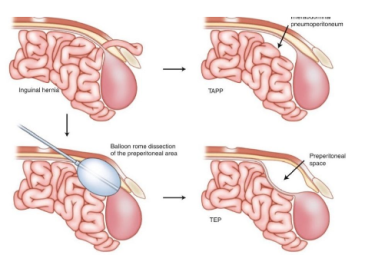
Because of fundamental anatomical differences, men are more likely than women to develop inguinal hernias, and the location where these hernias most frequently arise serves a fundamentally different purpose in men than it does in women.
Inguinal hernias are a type of protrusion that develops in the lower abdomen, or groyne, frequently as a result of coughing or straining. Sometimes it travels towards the scrotum. It typically happens when fatty tissue or a portion of the colon protrudes through the inguinal canal, a small opening in the lower abdominal wall.
B. Femoral Hernia
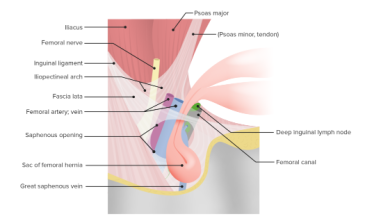
It frequently affects women. They are caused by a weakening in the lower groyne area, which is typically brought on by pregnancy and childbirth. Since these hernias are more likely to develop complications, they should be treated as soon as they are discovered.
2. (Umbilical / Para umbilical Hernia) - Naval hernia
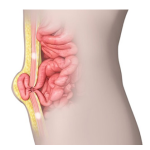
When a portion of the digestive tract pokes through the abdominal opening for the umbilical cord, it occurs. These hernias can develop in newborn babies at or shortly after delivery and can go away by the time the child is three or four years old.
However, the zone of deficiency can persist throughout life and affect men, women, and children at any time. Umbilical hernias in adults won’t go away and, given enough time, may even continue to get worse.
They can occasionally be caused by stomach pressure, being overweight, excessive hacking, or pregnancy.
3. Post-surgery hernia (Incisional hernia)
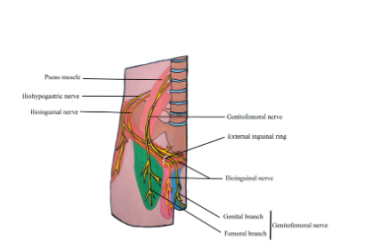
It occurs because of the scar that a previous cautious activity in the stomach partition left behind. The patient may notice pain or a lump where recent work has been done.
It is typically observed in large patients and in persistent conditions that increase intraabdominal pressure.
It could also be observed with occasionally postponed wound healing due to any justification. Similar to an inguinal hernia, it may be confusing and necessitates an emergency medical operation.
4. Spigelian hernia
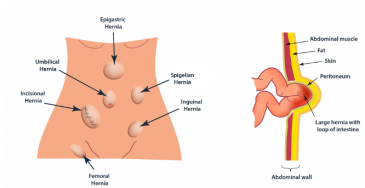
It happens through the Spigelian sash. (it is the aponeurotic layer between the rectus muscle and semilunar line).
What Causes Hernias?
Some Common Causes Of Muscle Weakness Or Strain That Can Lead To A Hernia Include:
- Damage From An Accident Or Surgery;
- Strenuous Exercise Or Lifting Heavy Weights;
- A Congenital Condition That Develops In The Womb And Is Present From Birth.
- Damage From An Injury Or Surgery
- Pregnancy, Particularly When There Are Several Pregnancies
- Constipation, Which Makes It Difficult For You To Urinate;
- Being Overweight Or Obese
- Ascites
You Are More Likely To Get A Hernia If You Have Certain Risk Factors.
They Include:
- Being Elderly
- Having A Chronic Cough (Perhaps Brought On By The Repeated Rise In Stomach Pressure)
- Having Cystic Fibrosis
- Being Born Early Or With A Low Birth Weight
- Being Underweight
- Being Pregnant
- Having Chronic Constipation
- And Being Overweight Or Obese
- Smoking, Which Weakens Connective Tissue
- A History Of Hernias In Oneself Or One’s Family.
Hernia Symptoms
You can feel a bump on either side of your pubic bone, which is where your groyne and thigh connect if you have an inguinal hernia.
When you’re lying down, the lump could seem to “disappear.” When you’re standing up, bending over, or coughing, you have a greater chance of feeling your hernia through touch. There may also be discomfort or soreness in the vicinity of the bump.
How to Hernia treatment
1. A hernia can only be adequately treated by surgical correction. The extent of your hernia and the intensity of your symptoms will determine whether you require surgery.
2. Simply keeping an eye on your hernia for potential consequences may be enough for your doctor. This strategy is known as watchful waiting.
3. Wearing a truss might occasionally assist to reduce the symptoms of a hernia. An undergarment that provides support and helps to retain the hernia in place is called a truss. Before wearing a truss, always consult your doctor to ensure that it fits properly.
4. OTC and prescription drugs that lessen stomach acid can ease your discomfort and improve your symptoms if you have a hiatal hernia. Antacids, H2 receptor blockers, and proton pump inhibitors are a few of these.
Some FAQ For Hernia Laparoscopy
Laparoscopic repair is preferable to open repair in the near term in terms of less blood loss, less perioperative problems, and shorter hospital stay, according to recent studies.
Success rates between 90 and 99 % are frequently reported. In many circumstances, mesh procedures give a lower risk of hernia recurrence than non-mesh surgeries. Unfortunately, some fixes can result in a 5–15% increase in the prevalence of chronic pain.
The most dangerous complications of hernia are:
1. Irreducibility- contents of hernia like omentum, do not go back, even on gentle pressure.
2. Obstruction: when the intestine is the content it may also result in obstruction (intestinal blockage), which is extremely dangerous.
3. Strangulation: It occurs when the blood supply to the herniated intestine is cut off or greatly reduced, causing the bowel tissue to die or rupture.

